AMD Announces 7th Gen Bristol Ridge PRO APUs with Extended Support
by Ian Cutress on October 4, 2016 8:30 AM EST- Posted in
- CPUs
- AMD
- APUs
- Enterprise
- Enterprise CPUs
- B2B
- PRO
- Professional
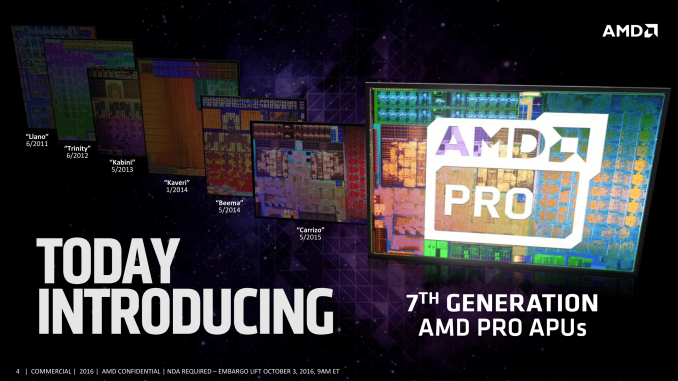
There are a number of directions for ‘professional grade’ processors in the market, varying from embedded to long-life support to server functionality. AMD’s PRO lines of processors are akin to their consumer counterparts, except they run a guaranteed lifecycle of support with ‘image stability’ (guaranteed OS images) and extended OEM warranties. AMD’s PRO line typically covers both embedded systems via the BGA lower parts and commercial/enterprise systems with socketed units. This week AMD is announcing their PRO line using the latest AMD microarchitecture, Bristol Ridge, along with continued support for customer requested features.
If you’ve ever browsed for an OEM system, or in a brick-and-mortar shop, you may have come across a system labeled something along the lines of ‘PRO A8’ using an AMD APU. I recently wrote a small news piece which involved an HP system in my local store with an OEM-only APU. These PRO parts enable an OEM to build a particular system, either as a business-to-business sale or directly to customers, and guarantee a fixed longevity for replacements to that system. This is a requirement for a lot of government and business electronic installations – the ability to replace like-for-like in the event of failure. AMD states that the unit shipments of their PRO processor line for commercial, enterprise and the public sector has risen by 45% since mid-2014, or a 20.4% compound annual growth rate (CAGR).
The processors announced today are direct analogues of the consumer grade processors announced a couple of weeks ago, identical in specifications but with PRO in the name and a direct focus on support structures, management, virtualization, security and performance comparisons.
| AMD 7th Generation Bristol Ridge PRO Processors | ||||||
| Modules/ Threads |
L2 Cache | CPU Base / Turbo (MHz) |
GPU SPs | GPU Base / Turbo (MHz) |
TDP | |
| PRO A12-9800 | 2M / 4T | 2 MB | 3800 / 4200 | 512 | 800 / 1108 | 65W |
| PRO A10-9700 | 2M / 4T | 2 MB | 3500 / 3800 | 384 | 720 / 1029 | 65W |
| PRO A8-9600 | 2M / 4T | 2 MB | 3100 / 3400 | 384 | 655 / 900 | 65W |
| PRO A6-9500 | 1M / 2T | 1 MB | 3500 / 3800 | 384 | 720 / 1029 | 65W |
| PRO A12-9800E | 2M / 4T | 2 MB | 3100 / 3800 | 512 | 655 / 900 | 35W |
| PRO A10-9700E | 2M / 4T | 2 MB | 3000 / 3500 | 384 | 600 / 847 | 35W |
| PRO A6-9500E | 1M / 2T | 1 MB | 3000 / 3400 | 256 | 576 / 800 | 35W |
All these processors will support DDR4-2400 as standard, and offer USB 3.1 (10 Gbps) support via the appropriate chipset and Type-C with a re-driver chip to support reversible insertion (this is the same as the consumer platform). These new processors are all socketed parts designed for the AM4 platform for now, with BGA components likely to be declared later down the line.
With the PRO APUs, AMD uses an ARM Cortex-A5 to implement ARM TrustZone, offering software agnostic (compared to Intel which does not) support for hardware-based security. This includes Secure Boot, Content Protection, per-Application security, fTPM 2.0, and support for Microsoft Device Guard, Windows Hello, independent fingerprint security, data protection and Bitlocker, among other things. AMD supports this via the DASH management protocol, which is ultimately CPU agnostic and allows users of other DASH systems to get up to speed.
AMD is positioning the APUs to be comparable to various Intel counterparts.
Performance-wise, for the launch, AMD states that in small form factors at 35W and mid-tier at 65W, performance compared to Intel is within 8% for the CPU, but AMD can offer +50-95% in graphics based or graphics accelerated workloads. In this case, AMD was positioning the PRO A12-9800E against the Core i5-6500T for the CPU comparison, and the PRO A12-9800 against the i5-6500 for the graphics comparison. We’ve asked to get these processors in for testing in order to compare.
The first systems using the new 7th Gen PRO APUs will be a set of HP Elitedesk 705 G3 systems, in Mini, SFF and mini-tower form factors. Due to the way these commercial systems are promoted, pricing and specifications will depend highly on the support contract aligned with the business customers. AMD is keen to point out that other customers will release their Bristol Ridge PRO based systems over the coming months.


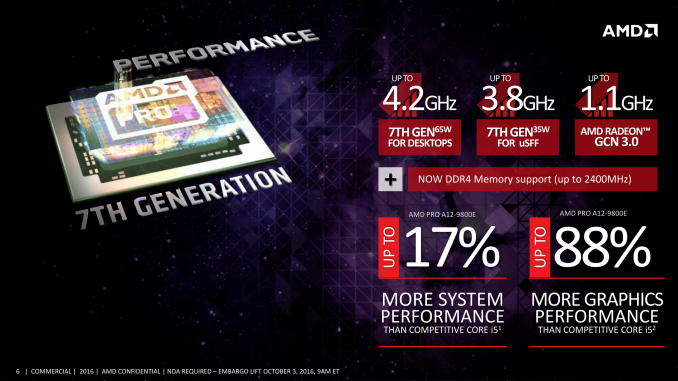
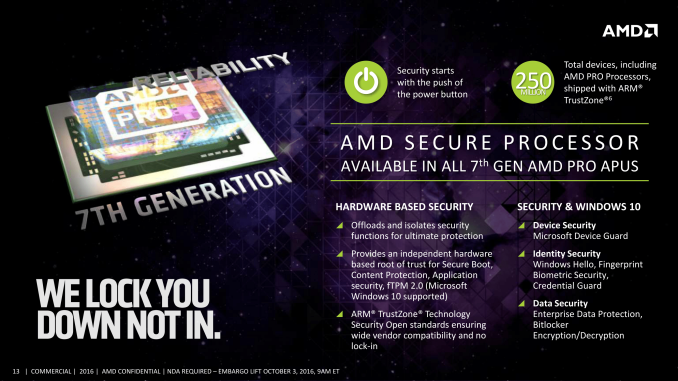
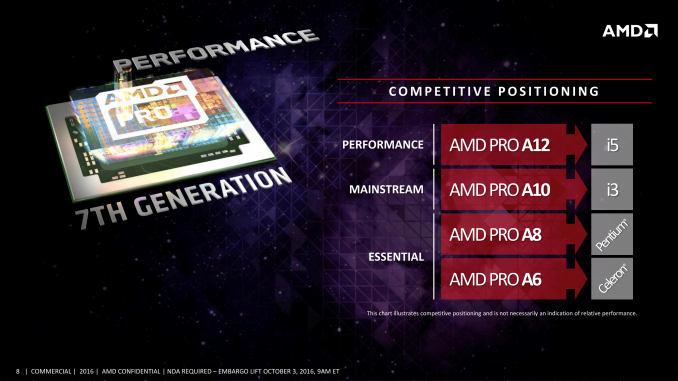
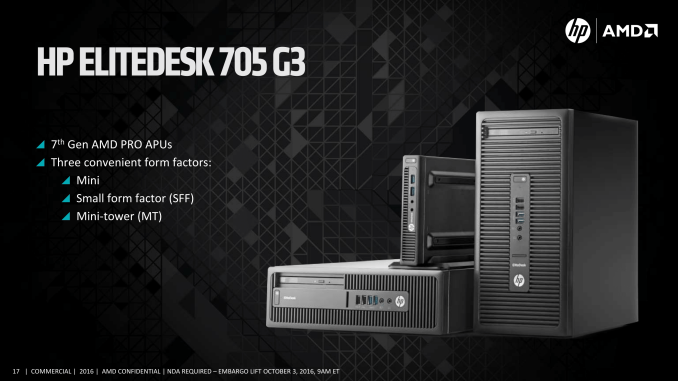














26 Comments
View All Comments
baka_toroi - Tuesday, October 4, 2016 - link
Zen can't come soon enough.ilt24 - Tuesday, October 4, 2016 - link
Are you going to do any Bristol Ridge benchmarking?ddriver - Tuesday, October 4, 2016 - link
Why bother, it says it is 17% faster than i5 LOL...Now, I don't doubt that its iGPU will be faster than the vanilla intel iGPU, but those 17% better "system performance" makes me skeptical. Probably some abstract term that has little to nothing to do with CPU performance.
MrSpadge - Tuesday, October 4, 2016 - link
Only with OpenCL acceleration in a few hand-picked corner cases.Meteor2 - Tuesday, October 4, 2016 - link
That 17% claim is bizarre, when their previous slides suggest parity for 'system' performance against an i5, at best. I've looked through the slides and can't see how they can claim that.KOneJ - Tuesday, October 4, 2016 - link
There is a footnote stating that the 17% greater performance was comparing the Intel Core i5-6500T with the AMD A12-9800E, which both officially have a 35W TDP. They can claim that under a particular benchmark (I may very well be mistaken but I think that it's PCMark Home 8. Don't quote me on that though.) which takes into account both the CPU and the iGPU performance and how it affects "productivity" across a variety of workloads. The parity is the A12-9800 with a 65W TDP against the i5-6500 with a 65W TDP. AMD compares favorably in the given benchmark at lower power envelopes due to the strength of the APU's iGPU. Don't get me wrong, but while I prefer AMD to Intel for both their product and the philosophy/principles/attitude, and I am a huge advocate for Bulldozer not having been Faildozer but rather a decent CMT uArch that got screwed by compilers under Windoze (In contrast with Gentoo...) and had difficulty with power efficiency and platform aging for servers, I can't argue that under Windoze for CPU-related tasks in general, the 17% claim is slated the wrong way. Yes, the APU's GCN-based iGPU smokes Intel's HD Graphics iGPUs (Iris [Pro] comes closer though that gets a lot more complex...), and yes, for people who play games at basic settings, it makes more sense without a dGPU, the fact is that if you're not rendering anything with the iGPU, the i5 is the better chip. Furthermore, it isn't known what the precise memory configurations were and performance varies from motherboard to motherboard. It may have been the i5 was running on an H110 motherboard with 3200MHz CL15 RAM running at 2133MHz since only Z170/X99 can use XMP OC profiles for DDR4, while the A12 was running on an X370 chipset motherboard with the same RAM at their maximum frequencies, boosting the iGPU. Or maybe not. The foot-note may have provided more info, or perhaps it didn't. Even then, ambient temperatures, airflow, thermal compound, and the CPU cooler used can all affect performance. I'm sure AMD's marketing department did their best to favor their new product no differently than Intel would. Again, not at all hating on AMD, and hating a little on Intel for some of their anti-competitive nature (I still consider Intel to be a very decent company, unlike Nvidia...), but those numbers were pulled from a marketing hat under narrow circumstances and should be disregarded. Under Windoze for most tasks that most people encounter mot of the time, the i5 is definitely the better chip. I any case, I hope this was enlightening.Cheers
lmcd - Tuesday, October 4, 2016 - link
Consider paragraph breaks, less things like "Windoze," and fewer anecdotes.Meteor2 - Tuesday, October 4, 2016 - link
I found it very interesting!Enverex - Wednesday, October 5, 2016 - link
"Iris [Pro] comes closer" - It doesn't. The Iris Pro series (e.g. 6200 and 580) massively outperform AMD's top APU. I'd agree if you were comparing the low-end basic ones they use, but not the Iris Pro range.plonk420 - Thursday, October 6, 2016 - link
i assume AMD is going to be more affordable than $250...